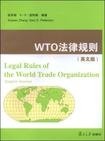WTO法律规则
出版时间:2008-11 出版社:复旦大学出版社 作者:张学森,G·D·派特森(Gary D.Patterson) 页数:404
Tag标签:无
前言
世界贸易组织(World Trade Organization,WTO)是当今世界最重要的政府间国际经济组织之一,与国际货币基金组织(IMF)和世界银行集团(World Bank Group)一起,构成了当代协调世界经济的三大支柱。相比而言,由于WTO在国际经济关系上协调的范围更广、影响力更大,而且具有不断向新领域拓展的职能,因而被誉为“世界经济领域的联合国”。中国作为WTO的正式成员,既要享受应有权利,充分利用半个多世纪以来以GATT/WTO为核心形成的多边贸易体制和贸易自由化的优秀成果,参与世界市场经济全球化的发展进程;又要承担相应义务,切实履行我国政府在人世谈判中的对外承诺,恪守WTO的基本规则和各项协定。因此,研究WTO有关规则、学习WTO专业知识、掌握WTO基本理念、培养WTO专业人才,成为摆在我们面前的一个长期的重要任务。 正是在这样的背景下,近年来,世界贸易组织(WTO)及其法律规则成为我国高等院校若干专业竞相开设的课程,而且,在国际法学、国际经济与贸易、商务英语等专业中,WTO及其法律规则的课程往往作为双语课程开设,纷纷进行双语课程建设。这就迫切需要一本有关WTO及其法律规则的双语教材,但要编写出一本好的教材是一项艰巨的任务。几年之前,在我国刚刚人世之际,笔者曾主编出版过作为国内第一部WTO英文读物的《WTO英文选读》(与刘光溪博士合作),一度被不少院校选作教材,而事实上该书并不是一本教材,也难以满足各方对教材的需要。曾拟改版为教材,但始终未能动笔。上海作为我国的经济中心城市,正在根据国家战略致力于国际经济、金融、贸易、航运等四个中心建设;上海市非常重视国际经济贸易专业高级人才的培养,把外贸经济本科教育列为上海市十大教育高地之一进行建设,而《WTO规则与运作》即是这一高地建设中的标志性教材之一,遂有今日之本书,名《WTO法律规则(英文版)》(Legal Rules of the World Trade Organization)。
内容概要
中国作为WTO的正式成员,既要享受应有权利,充分利用半个多世纪以来以来WTO为核心形成的多边贸易体制和贸易自由化的优秀成果,参与世界市场经济全球化的发展进程;又要承担相应义务,切实履行我国政府在人世谈判中的对外承诺,恪守WTO的基本规则和各项协定。因此,研究WTO有关规则、学习WTO专业知识、掌握WTO基本理念、培养WTO专业人才,成为摆在我们面前的一个长期的重要任务。 正是在这样的背景下,编者编写了此书。《WTO法律规则》既考虑了世界贸易组织(WTO)概论课程的特点,又努力满足WTO法律规则与实务课程的需要,试图找到介绍WTO概况与探讨其法律制度的某种平衡,因此是一个探讨和尝试。
作者简介
Xuesen Zhang,LL.D, East China University of Political Science and Law, Arbitrator, Senior Economist, Associate Professor of Law, Director of the Law Faculty,Shanghai Finance University Gary D. Patterson,J.D, Western State University College of Law at Fullerton, Professor, California State University at San Bernardino, Adjunct Professor, University of California at Riverside
书籍目录
Chapter One Theoretical Basis of the WTO1.1 The Theory of Comparative Advantage1.1.1 Basics of the Theory1.1.2 Historical Overview1.1.3 David Ricardos Numerical Example1.1.4 The Ricardian Model Assumptions and Results1.2 The Theory of Market Economy1.2.1 Spontaneous Order or “Invisible Hand”1.2.2 Free Market Economy1.2.3 Government Intervention1.2.4 Criticism of Market Economy1.3 The Theory of Sustainable Development1.3.1 Scope and Definitions1.3.2 History of Sustainable Development as a Policy Concept1.3.3 The Earth Summit and Environmental Sustainability1.3.4 WTO and Sustainable DevelopmentCASE STUDYCS 1.1 True Meaning and Intuition of the Theory of Comparative AdvantageCS 1.2 Chinas Market Economy Status(MES)Chapter Two Development of the WTOChapter Two Development of the WTO2.1 Basics of the WTO2.1.1 The WTO in Brief2.1.2 The Multilateral Trading System2.1.3 The GATT Years: from Havana to Marrakesh2.2 Development of the WTO2.2.1 The 1947 GATT Agreement2.2.2 GATT Multilateral Trade Negotiation Meetings2.2.3 Uruguay Round and the World Trade Organization2.3 The Organization of the WTO2.3.1 Introduction to WTO Organization2.3.2 WTO Organization Chart2.3.3 Membership, Alliances and Bureaucracy2.3.4 The Secretariat Chart2.3.5 Special Policies2.4 China and WTO2.4.1 Chinas WTO Entry2.4.2 The Right-and-Duty Balance in the WTOCASE STUDYCS 2.1 Doha Development RoundChapter Three Basic Principles of the WTO3.1 Reciprocity3.1.1 Two Folds of Reciprocity3.1.2 WTO Rules of Reciprocity3.1.3 Theoretical Interpretation of Reciprocity3.2 Non-discrimination3.2.1 Most-favoured-nation (MFN)3.2.2 National Treatment: Treating Foreigners and Locals Equally3.3 Liberalization of Trade3.3.1 Liberalization for Goods3.3.2 Liberalization for Services3.3.3 Limits to Liberalization3.4 Transparency3.4.1 Introduction to Transparency3.4.2 Publication and Administration of Trade Regulations3.4.3 Transparency Rules for GATS3.4.4 Transparency Rules for TRIPS3.4.5 Trade Policy Review Mechanism ( "TPRM" )CASE STUDYCS 3.1 MFN Exception: Promotion of Regional Intergration-Custom UnionsCS 3.2 National TreatmentChapter Four Trade in Goods4.1 Basics of Trade in Goods4.1.1 GATT 19944.1.2 Interpretation of GATT 1994 Articles4.1.3 Basic Principles of the GATT 1947/19944.2 Tariff Concessions4.2.1 Tariffs: More Bindings and Closer to Zero4.2.2 Tariff Cuts4.2.3 More Bindings4.2.4 Tariffs and Agriculture4.3 Non-tariff Measures4.3.1 Standards and Safety4.3.2 Import Licensing: Keeping Procedures Clear4.3.3 Rules for the Naluation of Goods at Customs4.3.4 Preshipment Inspection: a Further Check on Imports4.3.5 Rules of Origin4.3.6 Investment Measures: Reducing Trade Distortions4.4 Trade in Specific Products4.4.1 Textiles and Clothing4.4.2 Information Technology AgreementCASE STUDYCS 4.1 Sanitary and Phytosanitary MeasuresCS 4.2 SafeguardChapter Five Agriculture Agreement5.1 Basics of Trade in Agriculture5.1.1 New Rules5.1.2 Market Access5.1.3 Domestic Support5.1. 4 Export Subsidies: Limits on Spending and Quantities5.1.5 The Least-developed and Those Depending on Food Imports5.2 Understanding the Agriculture Agreement5.2.1 Introduction5.2.2 Market Access5.2.3 Domestic Support5.2.4 Export Competition/Subsidies5.2.5 Other Issues5.2.6 Net Food-Importing Developing Countries5.2.7 Summary5.3 The Agriculture Negotiations5.3.1 The Doha Mandate5.3.2 The Current NegotiationsCASE STUDYCS 5.1 Japan-Import Quotas on Dried Laver and Seasoned Laver (DS323)CS 5.2 European Communities-Protection of Trademarks and Geographical Indications for Agricultural Products and Foodstuffs (DS174, 290)Chapter Six Trade Remedy Measures6.1 Safeguards6.1.1 Safeguards: Emergency Actions for Imports of Particular ProductsChapter Seven Trade in ServicesChapter Eighe Intellectual Property RightsChapter Nine Otheer New Issues of the WTOChapter Ten Procedural Rules of the WTOAnnex Ⅰ Agreement Establishing the World Trade OrganizationAnnex Ⅱ Protocol on the Accession of the Peoples Republic 0f ChinaBibliography
章节摘录
9.2.5 Conclusions The motivation for this policy brief has been to consider whether intemational labor standards should be incorporated into the WTO and other trade agreements.The empirical literature summarized above suggests that mandating unsustainably high labor standards will not improve average wages and working conditions in poor countries. In fact, such mandates can both reduce the number of workers with better pay and working conditions and increase the number in poorer conditions, hence creating further inequality. The literature also shows that low labor standards do not provide developing countries with an unfair advantage in their export trade nor do they drive FDI. Hence, raising labor standards in poor countries will not protect jobs of workers in industrialized countries. What then should be done on the global level? If one looks at the economic development of the United States, Western Europe, Japan and other advanced industrialized countries over the past century, it is evident that the real incomes of workers have increased dramatically and that the conditions of work have improved concomitantly. In recent decades, there have been similar improvements in a substantial number of developing countries,especially in East and Southeast Asia as well as in Latin America. What the historical record suggests therefore is that it is not through the external enforcement of labor standards that improvements have been realized, but through internal economic and social development and growth in a countrys GNP. This means that governments in poor countries must implement solid growth strategies and target policies to eradicate poverty. Governments in rich countries can also help increase demand for poor countries output by reducing the barriers to imports from these countries. Finally, conscientious consumers in rich countries can also play a small role in increasing demand for products that are not produced by children or sweatshops, while MNCs can ensure their affiliates also follow better labor practices.
编辑推荐
《WTO法律规则(英文版)》主要是根据高等院校国际经济与贸易专业《WTO法律规则》(英文版)双语课程教学的要求而编写,兼顾了法学专业、商务英语、国际金融等专业相关课程教学的需要,同时也可以作为社会各界,特别是与WTO业务相关或对WTO业务感兴趣的专业人士,训练使用英语研究WTO有关法律文件,阅读WTO英文原著文章,用英文处理WTO实际问题的精读材料;可以作为WTO各类专业人才系列培训、研讨活动的教材或参考资料,以及WTO法律英语爱好者的自学教材。
图书封面
图书标签Tags
无
评论、评分、阅读与下载
